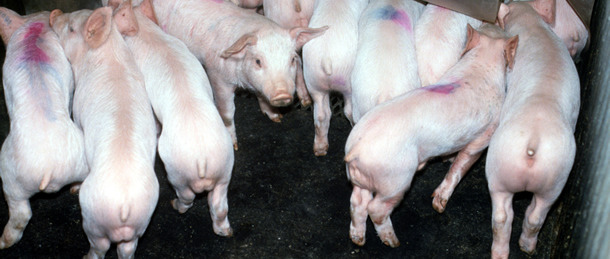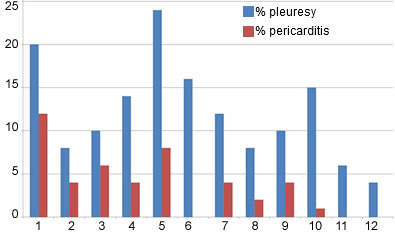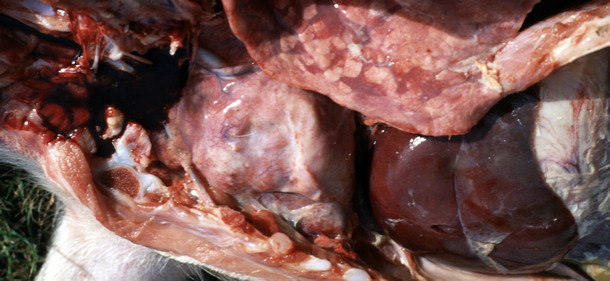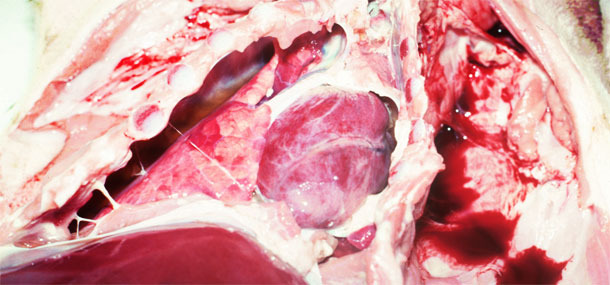This case concerns suboptimum health and production in a 500 sow indoor breeder feeder farm in Yorkshire, UK, as a result of challenges in the nursery section, which had a persistent effect on pigs through to slaughter.
The herd was long established and of basic health status. It was known to be positive for Mycoplasma hyopneumoniae (M hyo), PRRS, PCV2, Haemophilus parasuis and Streptococcus suis. As a result of longstanding issues with respiratory disease, particularly in the grower section, the herd changed from weekly production to 3 week batch farrowing several years before. As such it was targeted to produce 69 farrowings every 3 weeks. Production figures from the breeding herd are summarised in table 1.

Table 1. Breeding herd 12 month production data
| Average sow numbers | 506 |
| Total number farrowings | 1194 |
| Farrowing rate (FR) | 86.50% |
| Farrowing index (FI) | 2.36 |
| Born alive per litter | 12.3 |
| Born dead per litter | 0.7 |
| Reared per litter | 11.05 |
| Pigs reaed per sow per year | 26.1 |
| Average weaning weight | 7.3kg |
| Average weaning age | 26 days |
| Sow replacement rate | 48% |
Gilts were vaccinated prior to breeding for erysipelas, parvovirus and PRRS, and booster doses of vaccine for erysipelas and PRRS were given to all gilts and sows prior to farrowing. In addition, gilts were vaccinated against E. coli during pregnancy.
Vaccines provided to piglets were limited to M. hyo given at 7 days of age and PCV2 at 3 weeks of age. In addition, piglets received supplementary iron injections and toltrazuril orally at 4 days.
Historically the farm was reported to suffer “high levels” of joint ill in sucking piglets in the first 2 weeks of life and as such it had been a routine practice for many years to inject piglets at birth with a single 75 mg dose of long acting amoxicillin – given simultaneously with teeth clipping (i.e. 0.5 ml 15% LA amoxicillin, representing approximately 3 times the recommended dose).
Pigs were weaned as a 3 weekly batch at an average of 26 days of age into 3 flatdeck rooms. Historically the age range of pigs had been wide due to poor sow service discipline but in the last 12 months the age range was tightened to 23-29 days.
At weaning, pigs were fed a diet containing 3.1 kg/Tm zinc oxide for 2 weeks to prevent post weaning diarrhoea and 3 kg/Tm trimethomprim/sulphadiazine from 2- 4 weeks post weaning to prevent a known predictable problem with streptoccal meningitis.
Advice was sought primarily regarding disappointing post weaning performance of piglets in the nursery area but investigation suggested that the damage done had long-lasting effects.
Clinical investigation
The farm was visited 11 days after pigs had been weaned. History indicated that they ate well in the first week after weaning but at approximately 10 days post weaning started to “go backwards”.
Clinical inspection revealed:
1) Widespread coughing in all 3 rooms of pigs weaned 11 days previously along with a dry sneeze.
2) Specimen rectal temperatures ranged from 39-40.5 ºC.

3) Room temperature recordings suggested daily variations of less than 2 ºC and whilst the atmosphere appeared dry it was not noticeably polluted. Pigs’ lying behaviour suggested cross flow ventilation worked well and did not create significant draughts.
4) In all 3 rooms, each containing approximately 250 pigs (divided by room into small, medium and large pigs at weaning) between 5 and 15% were noticeably hollow in the abdomen, having lost body condition and bloom. Several were seen to be dyspnoeic and rectal temperatures from such animals ranged from 39 ºC to 40.5ºC (figure 1).

Fig 1. Recently weaned pigs in flatdecks with noticeable loss of condition and hollow abdomen
5) Feed provided for the immediate post weaning period was reported to have been consumed well (average 1 kg/pig over 6 days) but the expected rise in intake in the second week had not materialised as was the normal pattern for the herd.
6) Pigs weaned 3 weeks previously were noted to be no longer coughing, reported to having presented in exactly the same way as the most recently weaned group at 10 days post weaning but had received a 5 day course of amoxicillin at 20 mg/kg/day via the water. This treatment was administered at the earliest signs of coughing in the group (typically 8-10 days post weaning) and was reported to be required in most rooms. Within the room of pigs weaned 32 days previously the majority of the pigs looked well but some individuals had clearly faded and were not recovering, requiring euthanasia.
7) Production figures within the nursery were provided and are summarised in table 2.
Table 2. Postweaning performance for 12 months period
| Age at weaning | 26 days |
| Weight at weaning | 7.3 kg |
| Time in nursery | 35 days |
| Weight at exit from nursery | 18.5kg |
| Daily weight gain in nursery | 320 g/day |
| Mortality | 2.70% |
8) Slaughter data was provided to the farm as a result of the BPEX Pig Health Scheme (BPHS) under which veterinary assessments were made of 50 pigs per batch. Enzootic pneumonia type lung damage was scored consistently below 2 (on the 55 scoring system) but over a 2 year period pleurisy levels had ranged from 8-24% of pigs and pericarditis was recorded at 0-12% of pigs in each batch (see figure 2).

Fig. 2. Percentage of slaughter pigs with pleurisy and pericarditis over consecutive quarters. Intervention was made in quarter 9; therefore pigs slaughtered in quarters 11 & 12 represent the altered management (see below).
9) Physical appearance of the pigs throughout the grower stages (18 - 41 kg) was good and a similar picture was seen in the finishing houses although groups were noted to be somewhat variable in weight. Slaughter occurred at approximately 105 kg liveweight and growth rates from weaning to slaughter were quoted to average 640 g/day.
Further Investigations
Post Mortem Examination
Three poor growing pigs weaned 32 days previously were euthanased and examined post mortem along with 3 of the most severely dyspnoeic from the acutely affected group.
The 3 oldest pigs all showed evidence of polyserostis to varying degrees. All had extensive organised pleurisy and pericarditis whilst one also had peritonitis. There was minimal gross pathology in the 3 younger pigs other than some fibrinous accumulations in the pleura.

Figure 3. Post mortem examination of weaner showing pericardial filling and fibrinous tags over the liver

Figure 4. Post mortem examination of weaner showing acute pleural effusion and fibrinous tags that will soon organise to produce chronic fibrous pleurisy
Despite the fact that all pigs had received recent antibiotic treatment, either by water (amoxicillin for the young pigs) or feed (trimethoprim/sulphadiazine for the older group) bacteriology was attempted but revealed only a single isolate of Streptococcus suis from one of the older pigs.
Histopathology on the lungs revealed no significant damage and PRRS PCR was negative.
Seroprofiling
Cross sectional blood samples were taken from different aged groups of pigs and suggested that viral activity occurred following the move from nursery to grower sections, i.e. occurred after the clinical disease problem, and was thus not thought to be implicated.
Table 3. PRRS cross sectional serology (ELISA)
| Age | Number Positive |
| 37 days | 1/6 |
| 58 days | 0/6 |
| 79 days | 5/6 |
| 100 days | 6/6 |
Historical Sampling
Eighteen months prior to the investigation the herd had been screened as a potential trial site on behalf of a pharmaceutical company. Tonsil swabs had been collected from 20 piglets at weaning and, whilst the precise detailed bacterial results were not available it was reported that Haemophilus parasuis, Streptococcus suis and Mycoplasma hyorhinis had variably been isolated.
Interpretation
Whilst an accurate or definitive bacterial diagnosis could not be reached it was concluded that a bacterial challenge was occurring 7-10 days post weaning which produced a polyserostis affecting pigs variably and producing pleurisy in some that persisted to slaughter. Response to treatment was poor as a result of
1) Treatment given too late;
2) Inappropriate choice of antibiotic;
3) Disturbed microflora.
Attention was focussed on the potential effect of high dose treatment at birth with a broad spectrum antibiotic disturbing the normal balance of nasopharyngeal microflora of the pigs that would normally seed from birth. Use of the broad spectrum antibiotics at birth is well recognised as disturbing the long-term gut microbiota. Evidence of a similar effect on the nasopharynx is less clear although early colonisation with H.parasuis is known to affect susceptibility to acute Glässers disease later in life.)
Advice and response
Despite considerable reluctance on the part of both the unit manager and the farrowing house stockman to stop treating pigs at birth with amoxicillin, this was deemed to be essential to resolving the post weaning problems.
Since treatments stopped, batch growth through the nursery has improved to 348 g per day (over 10 batches) and mortality reduced to 1-2%. No significant levels of joint ill have been reported in young piglets.
The manager reports very little respiratory disease post weaning, and fading has largely ceased. Use of water soluble medication post weaning has reduced from being the norm to only having been applied to a total of 3 out of 30 rooms of pigs over the 10 batches.
Growth through to finish has improved although an increase in slaughter weight has made interpretation of figures difficult.
Two separate abattoir assessments of pigs slaughtered that had not been treated at birth have recorded evidence of pericarditis and pleurisy levels of 6 and 4% respectively.
Conclusion
Post weaning respiratory challenge to piglets can be complex and have long lasting effects such as chronic of pleurisy and pericarditis. This case study suggests that the well intentioned treatment of piglets at birth to prevent a historical problem may adversely affect the normal early nasopharyngeal or tonsil colonisation making pigs vulnerable to infections due to potential pathogens present within the herd that can have serious and damaging consequences. Allowing piglets to develop a normal intestinal flora without disruption is essential for gut health; this case suggests in some circumstances the same principle may be true for respiratory health.




